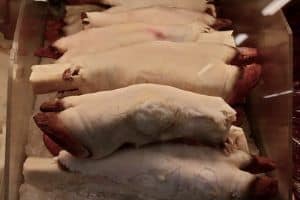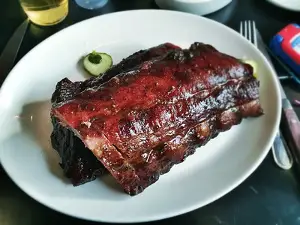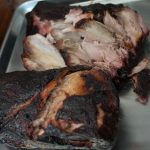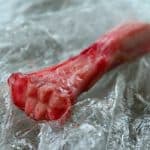
Despite being domesticated thousands of years ago, dogs are still naturally carnivores and derive some important nutrients from fresh meat and raw bones. Pig feet and hooves have been great snacks for dogs, and they are generally safe for canines to chew on.
Raw pig feet and pig hooves are inexpensive which is probably one of the reasons many pet parents don’t mind getting some for their dogs.
We’ve also heard severally that raw bones and hooves are great for the dental health of dogs and can even strengthen their digestive system, which further reinforces the conviction that they are great for dogs.
Who doesn’t want their pet to have healthy teeth and a stronger digestive system? I know I do. But how can you tell what pig hooves and feet are the best for your dog since they can be prepared in different ways.
[1] 5 different types of pig hooves
Pig hooves and feet can either be completely raw, or cooked in some way to kill off harmful bacteria and extend their shelf life. And there are different methods of cooking them, you can have them boiled, smoked or pickled.
So, what are the main differences between them?
The first difference between these types of hooves and feet is quite obvious. Raw pig hooves are uncooked while the others have been cooked in some way. Smoked pig hooves are slow-cooked or cured with indirect heat delivered with only hot smoke.
Smoked meat of all kinds are generally known for their high sodium content and pig hooves and feet are no different, and as such may not be the best option for your furry friend.
Boiled pig hooves and feet are cooked by boiling them in sizzling hot water with or without herbs and spices. Certain herbs and spices are definitely a no-no for dogs, but that’s not the major risk with boiled pig hooves and feet because bones that have been cooked become brittle and unsuitable for dogs.
Pickled meat is made by letting meat sit in pickle juice which is usually high in sodium or sometimes just brine. Pickle juice is made with brine, vinegar, sugar, garlic, onions, mustard, etc. Picked pig hooves and feet are made the same way which makes their sodium content very high and therefore unsuitable for consumption by dogs.
[2] Have pig hooves any nutrition?
Hooves of any kind—pig, cow, goat, horse— are primarily made of keratin which is a special protein composed of amino acids. It doesn’t seem like it, but pig feet and hooves actually contain a lot of nutrients, they are rich in proteins, fats and fatty acids and also contain several minerals and trace elements.
Some of the minerals in pig hooves include sodium, potassium, zinc, magnesium, selenium, phosphorus, etc., and feeding them to your pet is a great way for their bodies to absorb some of these nutrients. Cow and pig hooves are especially great for making bone broth because the minerals they contain tend to dissolve in boiling liquid which your pet will absorb by consuming the broth. Only the broth, not the cooked hooves.
[3] Why might eating hooves be dangerous for a dog?
Dogs love to chew which is why there are many chew toys for them. But some dogs are “power chewers” and need more than just a chew toy to keep them entertained long enough to avoid destruction around the house.
For this, many pet parents have turned to hooves as the go-to chew toy or treat to keep their dogs busy. And it does come with its benefits too. For instance, both cow and pig hooves are known to help dogs maintain healthy teeth. As dogs chew on hooves, they work to scrape away plaque and tartar on the surface of their teeth which is great for preventing a build-up.
Hooves are also usually hollowed which means you can sneak another healthy treat into the cavity such as peanut butter or cheese to encourage your pet to keep gnawing away at it. These animal hooves are also very cheap, and you can find them at any pet store.
While hooves seem to be the solution to curbing your pet’s destructive chewing habit, there are concerns about how safe they truly are. Many dogs will have no problem with chewing pig hooves. But if your dog is an aggressive chewer with a strong and persistent bite force, they may eventually crack the hoof and splinters with sharp edges can tear or lodge in their gums to cause immense pain and discomfort.
And if they swallow a part of the broken hoof with a jagged edge, this may puncture their digestive tract and pose a serious health risk. Some dogs can crack their own teeth in their fruitless attempt to crack a cow hoof.
There also has been choking hazards and intestinal blockage caused by dogs swallowing bits of hooves that were too big to safely travel through their GI tract. Some pet owners complain about the awful smell of cow and pig hooves, but apparently this should be the very least of your concerns.
Can dogs eat Rotisserie chicken?
[4] Raw pig’s feet vs cooked pig’s feet- which is better?
Pig feet are a good source of nutrients to compliment your dog’s normal diet and help satisfy his chewing appetite. Pig feet are strong and big bones which will hold a dog’s attention for quite some time, and they are great chew toys.
Raw pig feet are safe for dogs, they help maintain a healthy digestive system while also supplying dogs with certain minerals and nutrients. Uncooked bones, including raw pig feet, are an excellent option for anyone who wants a raw diet for their pet.
Dogs who have raw bones to chew on and play with also tend to be less destructive and less likely to tear your home apart. However, there has been concerns about raw meat and bones being contaminated with potentially harmful bacteria.
For elderly dogs or dogs who have compromised immune systems, bacterial infection can be very serious. But if raw pig feet and raw meat in general are handled with great care, then you can reduce the chance of feeding your pet infected meat. If you get your raw meat from reputable sources and apply the same safety measures you apply to your own food, then your dog should be fine.
Cooked pig feet may seem like a safer option because of the possible presence of bacteria in raw meat, but it’s not. You should know that cooking bone changes the texture and strength making them brittle and much easier to splinter.
Cooked pig feet pose more risk to dogs than raw pig feet because the former will be easier for your dog to crack and swallow which puts them at risk of a digestive tract problem. Cooked pig feet also take more time to prepare while serving them raw requires virtually no preparation.
[6] Are pig’s ears a better treat for your dog? Why or why not?
Pig ears are the external part of the ear which have been dehydrated. This part of the ear is primarily made of cartilage and skin, no bones or muscles, which makes it much easier for dogs to chew up and digest.
Pig ears contain a high amount of fat and are often greasy, this high fat content makes them unsuitable for overweight dogs or dogs prone to developing pancreatitis. Compared to hooves, pig ears may not be a better treat for your dog because they will make your dog have bad breath.
They don’t have the teeth-cleaning benefits of hooves and bones, and they certainly don’t keep your dog busy for long. But if your major concern is with the negative aspects of hooves and bones, then pig ears can be a better alternative, provided your dog is neither obese nor has problems with high-fat diets.
[7] What are the best sort of animal bones for a dog to chew?
Raw bones are certainly the best bones for dogs to chew. For clarity, raw bones mean uncooked bones filled with marrow. Some of the best raw bones for dogs includes tails, necks, hips, ribs, femurs, knuckles, and feet from animals like cows, pigs, and buffalo.
Weight-bearing bones of any animal such as leg bones are better than non weight-bearing bones because these bones are denser and less brittle. But they can also be too strong for small dog breeds and puppies.
You have to be careful when selecting a bone for your dog to chew, always remember that no bone is 100% safe, there is always a tiny chance that something may go wrong. To make sure that nothing goes wrong, supervise your dog when you give him a bone to chew.
[8] Can dogs eat pig hooves?
The short answer is yes, dogs can eat pig hooves. Raw pig hooves can be a great chew toy for managing your dog’s chewing habit. They are also good for helping your dog maintain healthy teeth and gum.
However, you have to be careful when giving your dog hooves to chew as they can cause a very serious health crisis, especially if your dog cracks it or swallows it.
Don’t give your dog a hoof that can completely fit into his mouth, to prevent a choking hazard. And once you notice that a hoof your pet has been chewing on is cracked or broken, remove all the parts and carefully discard them where you’re pet can’t find or reach them.






